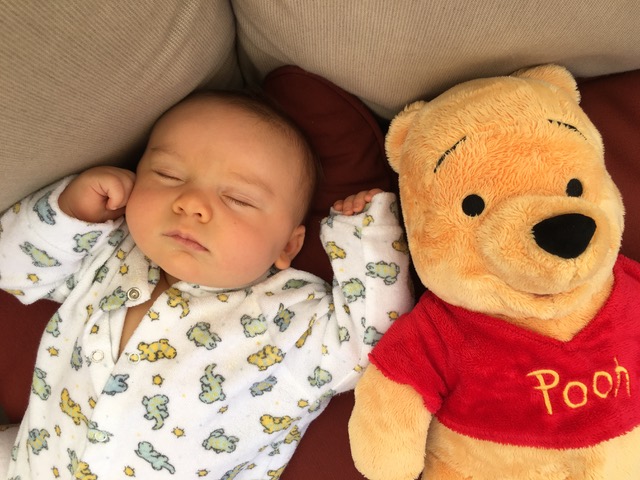Pulmonary vein (PV) stretch is proarrhythmic for atrial fibrillation (AF). AF patients often report that a left lateral (LL) body position can trigger arrhythmia symptoms. Because the PV myocardium is thought to trigger AF, we hypothesized that the LL compared to the supine body position increases PV wall stress. Functional cardiac magnetic resonance imaging was performed in supine and LL recumbent body position in awake condition in healthy human volunteers (n = 20). Following a change from supine to LL position, the heart moved in an anterior-LL direction in the thorax. The right superior PV diameter was increased by 19% and left atrial (LA) volume was larger by 17% in LL than supine position, respectively. The passive LA conduit fraction (normalized difference between maximum and pre-contraction LA volume) increased by 25% in LL compared to supine position. Local wall stress in the PV regions increased in LL compared to supine position, whereas this was not the case in the LA walls. In conclusion, a left lateral body position increases PV myocardial stress during the atrial relaxation phase of healthy volunteers. These results have implications for the mechanisms of posture-triggered AF.

 pubmed.ncbi.nlm.nih.gov
pubmed.ncbi.nlm.nih.gov
Patients with coronary artery disease (CAD) have depressed vagal modulation. Because the mortality risk from acute myocardial infarction is lower in patients with higher vagal modulation, methods that can increase vagal modulation are desirable for patients with CAD. The right lateral decubitus position has been found, in young healthy subjects, to lead to the highest vagal modulation among 3 recumbent positions using spectral heart rate variability (HRV) analysis. This study investigated which recumbent position can give rise to the highest vagal modulation in patients with severe CAD. Twenty-seven patients scheduled for coronary artery bypass graft surgery and 17 patients with angiographically normal coronary arteries were studied. Spectral HRV analysis was performed in random order on these patients in 3 recumbent positions: namely, the supine, left lateral decubitus, and right lateral decubitus positions. Normalized high-frequency power was the highest, whereas normalized low-frequency power and low/high-frequency power ratio in the right lateral decubitus position were the lowest, among the 3 recumbent positions in both groups of patients. The lower the normalized high-frequency power in the supine or left lateral decubitus position, the higher the increase in the normalized high-frequency power when the position was changed from supine or left lateral decubitus to right lateral decubitus in patients with severe CAD. Right lateral decubitus position can lead to the highest vagal modulation and the lowest sympathetic modulation among the 3 recumbent positions in patients with severe CAD. Therefore, the right lateral decubitus position can be used as an effective physiologic vagal enhancer in patients with severe CAD.

 pubmed.ncbi.nlm.nih.gov
pubmed.ncbi.nlm.nih.gov
The aim of this study was to evaluate the effect of the supine, left lateral decubitus, and right lateral decubitus positions on autonomic nervous activity in elderly adults by using spectral analysis of heart rate variability (HRV). Forty-five adults aged 73.6 ± 5.7 years were enrolled. After lying in the supine position, all participants moved to the lateral decubitus positions in a random order and maintained the positions for 10 min, while electrocardiographic data were recorded to measure HRV. The lowest heart rate continued for 10 min when participants were in the left lateral decubitus position compared with the other two positions (p < .001), while the HRV indexes remained unchanged. The low-frequency HRV to high-frequency HRV ratio (LF/HF) for the right lateral decubitus position was significantly lower than that for the other positions. The right lateral decubitus position may attenuate sympathetic nerve activity in elderly adults.

 pubmed.ncbi.nlm.nih.gov
pubmed.ncbi.nlm.nih.gov
This study compared the effect of 5 recumbent positions on cardiac autonomic nervous modulation in patients with coronary artery disease (CAD). Spectral heart rate variability analysis was performed on 33 CAD patients and 17 patients with patent coronary arteries in random order in 5 positions; namely, supine, right lateral decubitus, left lateral decubitus, left prone and right prone positions. In the right lateral decubitus position, the vagal modulation was the highest and the sympathetic modulation was the lowest among the 5 recumbent positions in the control group. In the CAD patients, the vagal modulation in the supine position was significantly lower than that in the other 4 positions. The lower the normalized high-frequency power (nHFP) in the supine position, the larger the percent age increase in nHFP when the position was changed from supine to another recumbent position in both CAD patients and controls. There was no significant change in the respiratory rate when the position was changed from supine to any of the other 4 positions. Right lateral decubitus position leads to the highest vagal modulation in the controls, whereas the supine position leads to the lowest vagal modulation in the CAD patients. In addition to the right lateral decubitus position, both the right and left prone positions can be used as a vagal enhancer in patients with CAD as compared with supine, especially for those patients who have severely reduced cardiac vagal modulation while supine.

 pubmed.ncbi.nlm.nih.gov
pubmed.ncbi.nlm.nih.gov

A left lateral body position increases pulmonary vein stress in healthy humans - PubMed
Pulmonary vein (PV) stretch is proarrhythmic for atrial fibrillation (AF). AF patients often report that a left lateral (LL) body position can trigger arrhythmia symptoms. Because the PV myocardium is thought to trigger AF, we hypothesized that the LL compared to the supine body position...
Patients with coronary artery disease (CAD) have depressed vagal modulation. Because the mortality risk from acute myocardial infarction is lower in patients with higher vagal modulation, methods that can increase vagal modulation are desirable for patients with CAD. The right lateral decubitus position has been found, in young healthy subjects, to lead to the highest vagal modulation among 3 recumbent positions using spectral heart rate variability (HRV) analysis. This study investigated which recumbent position can give rise to the highest vagal modulation in patients with severe CAD. Twenty-seven patients scheduled for coronary artery bypass graft surgery and 17 patients with angiographically normal coronary arteries were studied. Spectral HRV analysis was performed in random order on these patients in 3 recumbent positions: namely, the supine, left lateral decubitus, and right lateral decubitus positions. Normalized high-frequency power was the highest, whereas normalized low-frequency power and low/high-frequency power ratio in the right lateral decubitus position were the lowest, among the 3 recumbent positions in both groups of patients. The lower the normalized high-frequency power in the supine or left lateral decubitus position, the higher the increase in the normalized high-frequency power when the position was changed from supine or left lateral decubitus to right lateral decubitus in patients with severe CAD. Right lateral decubitus position can lead to the highest vagal modulation and the lowest sympathetic modulation among the 3 recumbent positions in patients with severe CAD. Therefore, the right lateral decubitus position can be used as an effective physiologic vagal enhancer in patients with severe CAD.

Comparison of three recumbent positions on vagal and sympathetic modulation using spectral heart rate variability in patients with coronary artery disease - PubMed
Patients with coronary artery disease (CAD) have depressed vagal modulation. Because the mortality risk from acute myocardial infarction is lower in patients with higher vagal modulation, methods that can increase vagal modulation are desirable for patients with CAD. The right lateral decubitus...
The aim of this study was to evaluate the effect of the supine, left lateral decubitus, and right lateral decubitus positions on autonomic nervous activity in elderly adults by using spectral analysis of heart rate variability (HRV). Forty-five adults aged 73.6 ± 5.7 years were enrolled. After lying in the supine position, all participants moved to the lateral decubitus positions in a random order and maintained the positions for 10 min, while electrocardiographic data were recorded to measure HRV. The lowest heart rate continued for 10 min when participants were in the left lateral decubitus position compared with the other two positions (p < .001), while the HRV indexes remained unchanged. The low-frequency HRV to high-frequency HRV ratio (LF/HF) for the right lateral decubitus position was significantly lower than that for the other positions. The right lateral decubitus position may attenuate sympathetic nerve activity in elderly adults.

The Cardiac Sympathetic Nerve Activity in the Elderly Is Attenuated in the Right Lateral Decubitus Position - PubMed
<span><b>Objectives:</b> The aim of this study was to evaluate the effect of the supine, left lateral decubitus, and right lateral decubitus positions on autonomic nervous activity in elderly adults by using spectral analysis of heart rate variability (HRV). <b>Method:</b> Forty-five adults aged...
This study compared the effect of 5 recumbent positions on cardiac autonomic nervous modulation in patients with coronary artery disease (CAD). Spectral heart rate variability analysis was performed on 33 CAD patients and 17 patients with patent coronary arteries in random order in 5 positions; namely, supine, right lateral decubitus, left lateral decubitus, left prone and right prone positions. In the right lateral decubitus position, the vagal modulation was the highest and the sympathetic modulation was the lowest among the 5 recumbent positions in the control group. In the CAD patients, the vagal modulation in the supine position was significantly lower than that in the other 4 positions. The lower the normalized high-frequency power (nHFP) in the supine position, the larger the percent age increase in nHFP when the position was changed from supine to another recumbent position in both CAD patients and controls. There was no significant change in the respiratory rate when the position was changed from supine to any of the other 4 positions. Right lateral decubitus position leads to the highest vagal modulation in the controls, whereas the supine position leads to the lowest vagal modulation in the CAD patients. In addition to the right lateral decubitus position, both the right and left prone positions can be used as a vagal enhancer in patients with CAD as compared with supine, especially for those patients who have severely reduced cardiac vagal modulation while supine.

Comparison of effect of 5 recumbent positions on autonomic nervous modulation in patients with coronary artery disease - PubMed
Right lateral decubitus position leads to the highest vagal modulation in the controls, whereas the supine position leads to the lowest vagal modulation in the CAD patients. In addition to the right lateral decubitus position, both the right and left prone positions can be used as a vagal...
Last edited:

